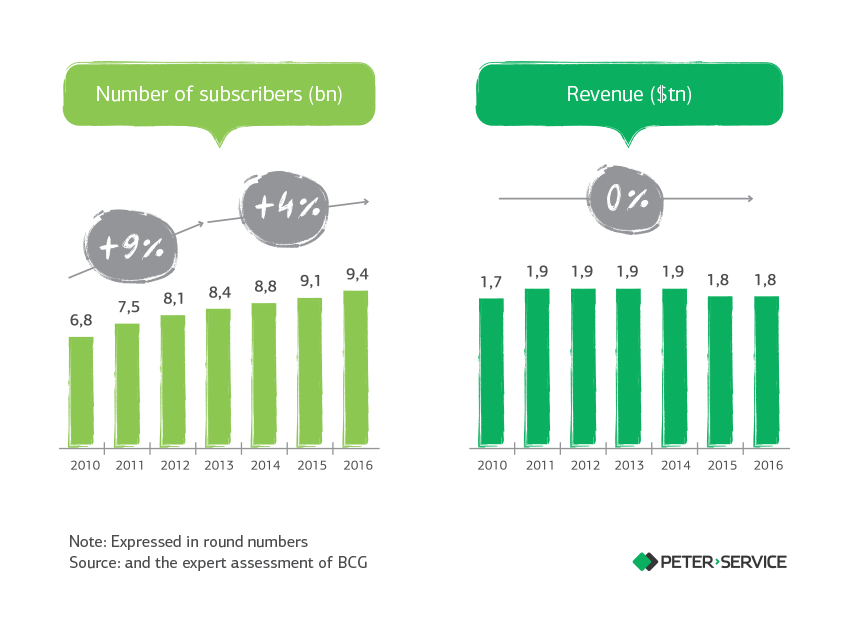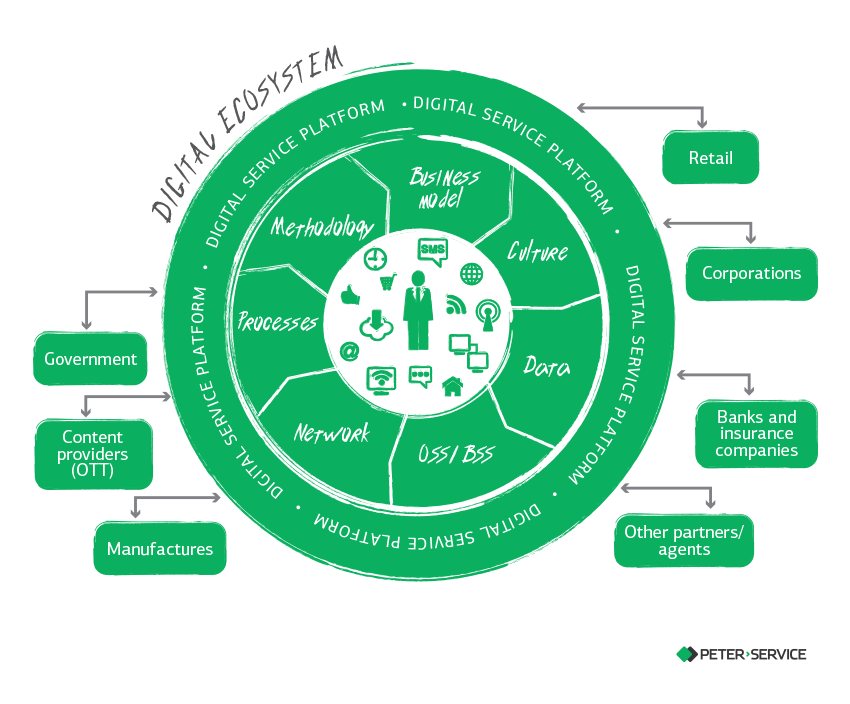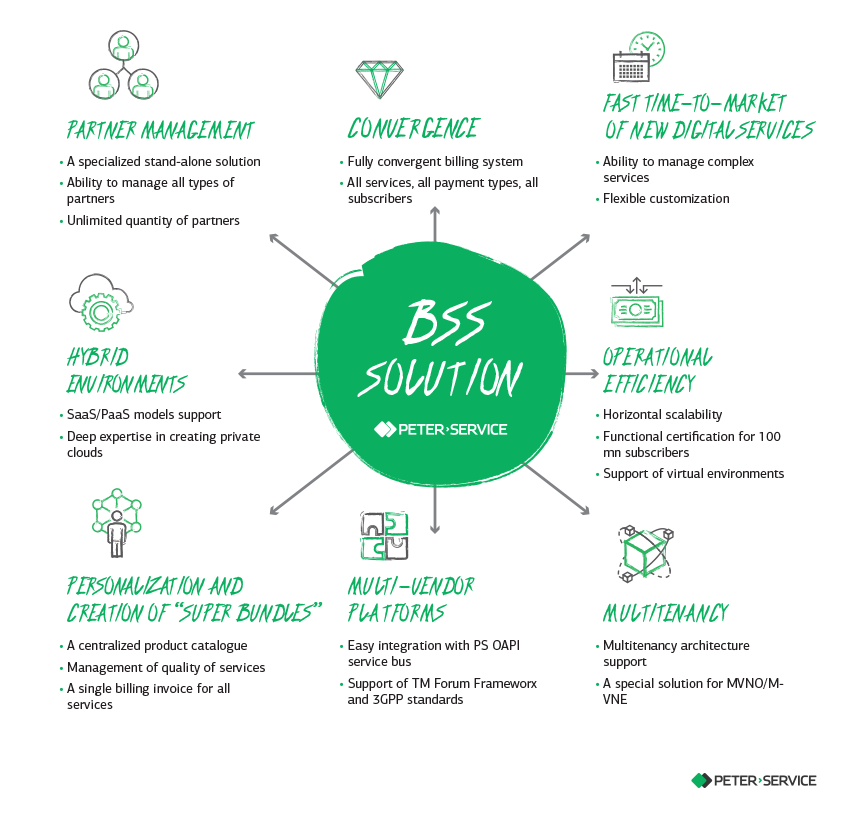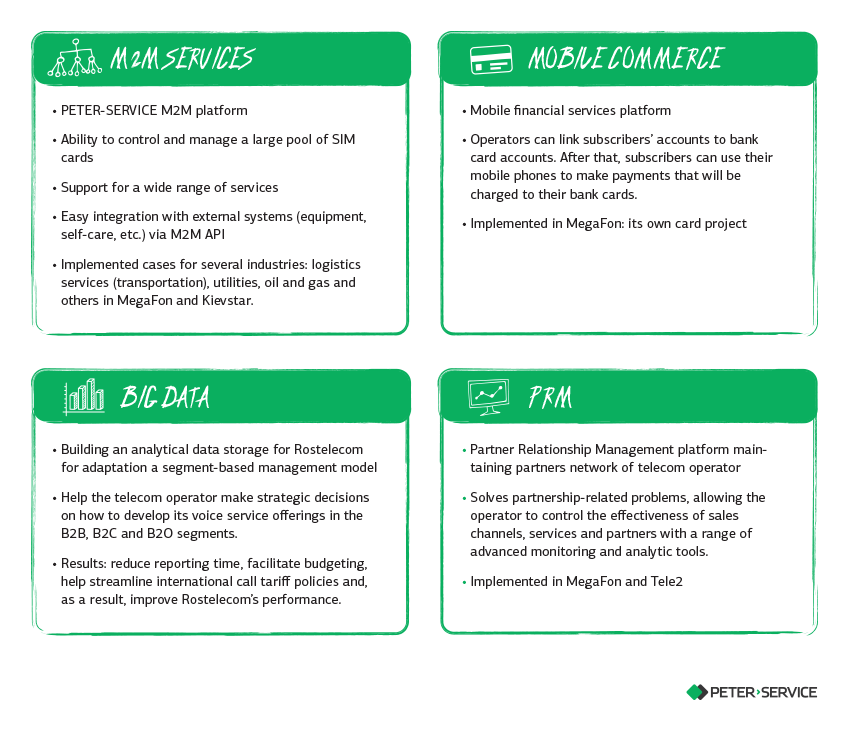BSS in the Digital Age
BSS systems in the era of digital transformation.
BSS/OSS systems are going through significant changes influenced by the new requirements of time. To ensure a leading service provider role for a telecom operator, the BSS shall evolve from a monolithic system of a single company to a unified platform of the entire digital eco-system.
Digital economy gathers pays
We live in an incredible age. The pace of changes around us is unbelievable. This is that pace of adapting new technologies to new discoveries or innovations which makes it essential to embark on the wave of changes. Otherwise, very soon this wave may sweep us once and for all. Digital economy is another trend that that we need to keep up with. In the recent few years, we have seen the birth of new products influenced by digital technologies, conventional business models change and entire economic domains evolve. Advancing mobile networks are the primary drivers of this digital transformation, with a resulting increase of speed and volumes of data transmission, development of cloud computing, emerging possibility to process and analyze big volumes of information, and introduction of IoT-based technologies. Leading analytics and consulting firms confirm that this process has already become a reality:
- Accenture: "By 2020, 25% of world economy will be digital".
- IDC: "By 2020, 50% of companies in the Global 2000 list will understand that the bulk of their business depends on the capabilities to design digital products, services and user experience. Industry leaders will get faster growth of profits from information-enabled products and services. To ensure development of such products and services, the global level of investments in DX initiatives (digital transformation initiatives) will reach 2.2 bn USD in 2019 which is almost 60% higher than in 2016".
- MarketsandMarkets: "The overall estimated volume of the digital transformation market will be 392.15 bn USD by 2021".
Looking ahead
Development of networks and the planned transition to 5G within the next few years will drive the birth of a "digital world" in which everything (people, machinery, devices) will continuously interact online by transferring various types of data via networks. For this reason, the Telecom industry itself will no longer be a vertical market – It is expanding as the number and complexity of objects involved in the digital interaction become higher. Industries are "blurring". Companies from other industries, such as banks, retailers, big corporations, are actively entering the Telecom segment wishing to provide digital services under their brands using an available infrastructure. Similarly, telecom operators are beginning to provide financial and other non-standard services. Further factors that directly affect the Telecom industry can be outlined.
For one, it is the decline of profits from traditional resources and the reduction of subscriber base growth. Active M&As in the telecom market are an implication of the current changes.

The second factor is that OTT providers are capturing the market. According to a study by Juniper Research, the potential losses of telecom operators caused by migration of subscribers from traditional services to services offered by OTT providers will amount to 104 bn USD in 2017 which accounts for 12% of their service revenues.

What you need to become a DSP
Against the backdrop of a drastic shift in the industry caused by digital transformation, telecom operators have just two options. They can either take the path of the transition from the model of Communication Service Provider (CSP) to the model of Digital Service Provider (DSP) tapping into related high-margin areas of the digital market, such as mobile finance, content distribution, mobile advertising in the B2C segment, cloud services, and the industrial IoT in the B2B segment. Alternatively, telecom operators can refuse to change their business model leaving all new opportunities to direct competitors and digital invaders and stay a pure CSP provider becoming less profitable every year.
Not surprisingly, leading telecom players choose the first option.
DSP's customer-focused centralized model has several important features:
- The end customer is placed in the center of an integrated network connecting multiple elements, each contributing to building a valuable service.
- All digital services are provided via a unified integrated platform – the digital service platform. Building this model requires many element:
- The entire infrastructure: networks and hardware
- All required software, in particular, the OSS/BSS system
- All necessary data, primarily, on customers and their preferences
- Streamlined processes including processes of partner interaction and internal processes
- Culture: all employees of a telecom operator must understand the company's destination and support the idea of digital transformation. This is ensured, inter alia, through the reduction of hierarchical levels and the top-down introduction of agile methodologies
- Change methodology
- And, most importantly, the business model itself.
- A new complete digital eco-system.

What is a digital-ready BSS?
As a pre-requisite of transformation, BSS/OSS systems are also going through significant changes influenced by the new requirements. To ensure a leading service provider role for a telecom operator, the BSS shall evolve from a monolithic system of a single company to a unified platform of the entire digital eco-system.
This is exactly the reason why the strategy of BSS vendors includes building, development and market promotion of the following functional and technical system capabilities:
-
Support of convergence and new business models. In the realities of the new economy, communications operators need to offer customers a wide range of services, tariffs and payments methods managed through a single BSS platform that should be capable of creating, delivering and supporting complex packaged offers while ensuring a comprehensive billing over several types of service.
-
Availability of open application program interfaces (APIs) and microservices that facilitate the realization of the model to build a partnership-based digital eco-system and simplify mutual integration of various vendors’ products.
-
Support of integrated customer experience management considering that the end customer of the digital service provider is placed in the middle of an integrated network connecting multiple elements, each contributing to building a valuable service. Customer experience should become a competitive advantage including by facilitating a full and convenient interaction with the company over all possible digital channels in the 24×7×365 mode. And, this will consider not only processes of technical support and social marketing, but also the possibility of buying and managing any services from any digital device.
-
Support M2M management and development of an end-to-end stack covering CMP, AEP and vertical solutions. Availability of this platform enables the operator to diversify their business model away from stagnating classical revenue streams towards Digital Business models that can cover B2x as well as B2B2X scenarios.
-
Possibility of deploying a BSS system in a cloud infrastructure. A switch to cloud platforms of all types including hybrid is a today's global trend embracing all industries including Telecom.
-
Analytics based intelligence capabilities through which it is possible to promote visibility of what is happening in any part of the new poly-dimensional and multi-faceted value chain of a digital product/service, and enable fast reaction to surrounding events.
-
Implementation of the multitenancy principle providing the possibility to lease a part of the operator's infrastructure to several business entities at a time while safeguarding their full independence and data security. This feature is needed for supporting the MVNO/MVNE model which actively progresses in the market.
-
The BSS architecture should consider to the need to process Big data helping telecom operators to realize complex customer data management models both to enhance the customer experience of their subscribers and to generate additional profit bringing data-based services to the market.
-
Development of the partner management feature in the new eco-system including a parallel support of an unlimited number of partners and a possibility to correctly calculate revenues directly unrelated to the traditional Telecom business.
-
Standardization and short Time-to-Market requirements force BSS vendors to support industry standards including TM Forum, 3GPP, introduce agile methodologies and apply DevOps, build stand-alone solutions, and offer managed services.
Transforming into a DSP with Peter-Service solutions
BSS Peter-Service is being developed reflecting market trends and focusing on the strategic model of becoming a technological platform embracing all necessary functional and technological features which will help telecom operators successfully switch to the DSP model and secure a leading position in the new digital economy.

Examples of projects that support telecom operators' DSP transition strategy (selective):
